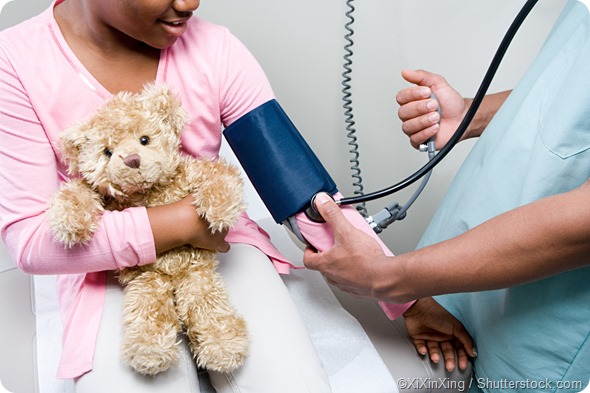Although people usually assume that only middle-aged or elderly people develop high blood pressure (hypertension), it is also possible for the condition to arise in teenagers, children and even babies.
 High Blood Pressure in Children" />
High Blood Pressure in Children" />
The American Heart Association advises that all children should be checked for high blood pressure on a yearly basis, as detecting the condition and treating it early will improve the child’s health and reduce or prevent the harmful effects of the condition.
Causes
Hypertension in children is usually caused by another underlying health condition such as heart disease or kidney disease. Itis therefore referred to as secondary hypertension and once the medical condition is resolved, the blood pressure typically returns to normal. Secondary hypertension may also be caused by the following conditions:
- Hyperthyroidism
- Adrenal disorder
- Sleep problems, particularly sleep apnea
- Renal artery stenosis
Some medications can increase blood pressure, but, again, the blood pressure usually returns to normal if the medication is discontinued.
In some cases, a doctor cannot determine what is causing the hypertension, in which case the condition is referred to as primary or essential hypertension. Various factors that are known to contribute to the risk of primary hypertension include:
- Overweight or obesity (body mass index >25)
- Family history of hypertension
- High cholesterol and triglycerides
- Type 2 diabetes or raised fasting blood sugar
Complications
Children with hypertension often develop sleep apnea and breathe abnormally while they sleep, particularly if the child is overweight. If the hypertension persists into adulthood, the person is at an increased risk of kidney disease, stroke, heart attack and heart failure.
Tests and diagnosis
Blood pressure is measured using an inflatable arm cuff and blood pressure gauge. The blood pressure measurement is made up of two readings. The first (upper) number is a measurement of systolic blood pressure, which is the pressure in the arteries when the heart beats. The second (lower) number is a measurement of the diastolic pressure, which is the pressure in the arteries between heartbeats.
One blood pressure measurement is not sufficient to diagnose hypertension. In order to be diagnosed,the child needs to have an abnormal reading on at least three visits to the doctor, and during a visit, the measurement may be taken several times to ensure it is accurate.
What is considered as “normal” blood pressure is relative and depends on the child’s gender, age and height. If hypertension is diagnosed, the child should then be checked approximately every six months. A doctor may also perform the following tests to check for other underlying conditions that may be causing the problem:
- Echocardiogram to check blood flow through the heart
- Ultrasound to assess the kidneys
- Blood test to check blood cell counts, blood glucose and function of the kidneys
- Urine analysis
Treatment
Hypertension in children is generally managed by making lifestyle changes such as exercising regularly, eating a diet that is good for the heart and maintaining a healthy weight. If these measures alone are not enough to resolve the problem, the following medications may be prescribed:
- Diuretics: These act on the kidneys to remove sodium and water, which lowers the blood pressure
- Beta blockers: These reduce the amount of work the heart has to do to pump blood around the body, thereby lowering the rate and force of the heartbeat
- Angiotensin-converting enzyme (ACE) inhibitors: These relax the blood vessels by preventing the formation of a chemical that narrows the vessels, thereby improving blood flow and reducing blood pressure
- Angiotensin II receptor blockers: The mechanism here is the same as for ACE inhibitors
- Calcium channel blockers: These medications help relax blood vessel muscles and slow heart rate.
Sources
- Mayo Clinic, High Blood Pressure in Children, www.mayoclinic.org/.../con-20033799
- American Heart Association, High Blood Pressure in Children, www.heart.org/.../...Blood-Pressure-in-Children_UCM_301868_Article.jsp
Further Reading